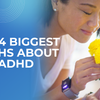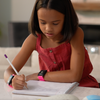TouchPoints for Classroom Use

Stress is a normal part of students’ lives. But while stress can be a good motivator, it can also be overwhelming, affecting kids’ overall health, including sleep and brain function. When stressed, some children find it hard to calm down. They are more prone to impulsive and aggressive behavior, acting out, inability to focus, as well as clinging or distant behavior. This is when you need TouchPoints. We help teachers, therapists and parents in assisting children to cope with stress by using TouchPoints, which can be worn at home or school.
What are TouchPoints?
TouchPoints are patented stress relief wearables that are scientifically proven to reduce the negative impacts of stress. They do this by altering the body's stress response with scientifically-proven BLAST (Bi-lateral Alternating Stimulation Tactile) technology. BLAST uses gentle, alternating vibrations on each side of the body to shift your brain from your default "fight or flight" response to your calm and in-control response. They are shown to help kids calm stress, improve sensory integration, reduce headaches and stomachaches due to anxiety, and improve focus in the classroom.
How do you wear them?
TouchPoints are worn as a pair, either embedded into zippered sweatbands placed on upper arms or ankles, or on the wrist with watchbands. They can also be placed by themselves in pockets, tank top straps, or socks. As long as one is on the right side and one is on the left side of the body in corresponding areas, the TouchPoints will work as needed.
(Note the TouchPoints are modular so the center units can be removed from the watchbands and placed in the zippered sweatbands or in pockets, socks, or tank top straps. They do not have to touch the skin to be effective.)
When should a child use them?
TouchPoints should produce calm within a few minutes and can be turned off, or the child can keep wearing them for longer periods of time. In quieter environments, it is recommended to use TouchPoints in zipper sweatbands or in socks to muffle the sound of the vibrations.
For separation anxiety, it is recommended to wear the devices before school for 15 minutes in the morning, when anxiety spikes during the day and a child wants to call a parent, gets a somatic reaction (stomachache, headache), or becomes tearful or upset.
Before presentations and tests, TouchPoints should be worn 10 minutes to calm anxiety. Students can wear them during the duration of the presentation or test as well.
In order to manage anger, fighting, and irritability, TouchPoints should be used for the duration of high-risk situations such as recess or lunch if a child has a hard time with sensory integration, transitions, or is prone to impulsive or aggressive behavior. Turn the devices on prior and leave them on during the entire recess or lunch period.
For perfectionism, children can wear TouchPoints during assignments/homework/tests to prevent frustration and re-doing things. They can also help with getting them started and preventing the overwhelming feeling of not knowing exactly how to begin a task. Children who have a hard time turning in work if it’s not perfect can wear TouchPoints for a few minutes if they feel stuck in re-doing their work, or are worried that they made a mistake.
If a child is avoiding a feared situation (recess for fear of bees, talking to a friend for fear of rejection, asking a question due to freezing with anxiety…), TouchPoints can be used to provide calm and they will be more likely to engage in the situation or activity with them vibrating.
Those with special needs (children under ED classifications or with developmental disabilities) may wear TouchPoints for the entire day to promote regulation. TouchPoints may not last the entire school day depending on the setting and take 2-3 hours to charge. Some classrooms cycle more than 1 set per child for this reason.
For conflicts, have children trying to work out an issue between each other hand them back and forth. When calm, they have a much better chance of conflict resolution.
To improve focus, TouchPoints can be ‘spot used’ as needed to help children stay on task if they become distractible.
Note: Some children may only want TouchPoints for about 1-2 minutes and then say they are annoying. This means the TouchPoints have done their job and they don’t need continuous stimulus, so they can be turned off prior to the recommended duration.
How do most schools use them?
Nurse: One set for children with anxiety related symptoms. Used as the first line for headaches, stomach aches, nausea.
Special Education: At least one set per classroom to lower fight/flight behaviors. In fact, one UK study found a weekly incidence of 283 episodes of headbanging resolved to only 18 with continuous TouchPoints use.
Calming/Sensory Rooms: Have TouchPoints as a choice for a soothing activity. Better yet - Don’t have the children leave the classroom. They can use TouchPoints for calm so they don’t miss instruction!
Gifted Classrooms: At least one set to calm gifted intensity/anxiety as needed.
Principal’s Office: One set to have children hold when they get called into the Principal's office.
Teachers, Front Office, Staff, etc: Have at least one set to use for managing stress and difficult days.
OT/PT/Speech: Used during sessions.
How does a child turn them on and sync them?
- Press the button on one TouchPoint to turn it on and then press again to get to the blue (sleep/meditation) setting. For yellow (calm/focus), press once more, and for purple (reducing anger/irritability), press once more.
- Face the lights of the TouchPoints close to each other. Press the other TouchPoint’s button once. The second device should change to match the same color as the first and it will begin vibrating in an alternating pattern.
- Put one TouchPoint on each side of the body. The first time a child uses the TouchPoints, it is recommended to try each setting for one minute, starting with the yellow (calm/focus) setting. See which setting works best to relieve stress.
- To turn off TouchPoints, hold them apart from each other and press the button on each until you see the green light, which will turn off when the TouchPoints are off.
It is recommended to begin with the medium vibration setting (yellow), as most individuals prefer that setting. There are 3 settings for the TouchPoints and the user is able to test out which is most effective for them. The way to know the “best” setting is by gauging on a scale of 0-10 how stressed the person feels and then after 30 seconds of use, reassess. The stress level should have gone down at least 3 points if it was higher than a 6 to start. If it didn’t, try a different setting to see if faster stress relief can be achieved.
How do they charge? How long does the battery last?
TouchPoints are rechargeable with a micro USB charger and both can be charged at once. Charging takes approximately 2-3 hours and they will run 4-7 hours continuous on one charge, depending on the setting.
How can districts purchase these?
Individual sets or Institutional Packs in sets of 10 can be purchased online at thetouchpointsolution.com.
For orders over 50 units, contact TouchPoints Account Manager at mark.holder@thetouchpointsolution.com.
For more information, visit the TouchPoint website.
-
Posted in
Moms/Families





